
The West Coast Main Line (WCML) is one of the most important railway corridors in the United Kingdom, connecting the major cities of London and Glasgow with branches to Birmingham, Liverpool, Manchester and Edinburgh. It is one of the busiest mixed-traffic railway routes in Europe, carrying a mixture of intercity rail, regional rail, commuter rail and rail freight traffic. The core route of the WCML runs from London to Glasgow for 399 miles (642 km) and was opened from 1837 to 1869. With additional lines deviating to Northampton, Birmingham, Manchester, Liverpool and Edinburgh, this totals a route mileage of 700 miles (1,127 km). The Glasgow–Edinburgh via Carstairs line connects the WCML to Edinburgh. However, the main London–Edinburgh route is the East Coast Main Line. Several sections of the WCML form part of the suburban railway systems in London, Coventry, Birmingham, Liverpool, Manchester and Glasgow, with many more smaller commuter stations, as well as providing links to more rural towns.

Winslow is a market town and civil parish in north Buckinghamshire, England, within the Buckinghamshire Council unitary authority area. It has a population of just over 4,400. It is located approximately 6 miles (9.7 km) south-east of Buckingham, and 7 miles (11 km) south-west of Bletchley.
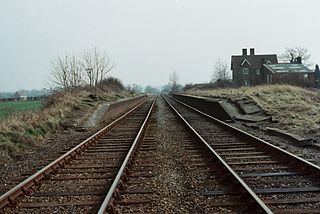
Verney Junction railway station was an isolated railway station at a four-way railway junction in Buckinghamshire, open from 1868 to 1968; a junction existed at the site without a station from 1851.

Bletchley is a constituent town of Milton Keynes, Buckinghamshire, England. It is situated in the south-west of the city, and is split between the civil parishes of Bletchley and Fenny Stratford and West Bletchley. In 2011, the two parishes had a combined population of 37,114.

Rugby railway station serves the market town of Rugby in Warwickshire, England. The current station dates from 1885; two previous stations dating from 1838 and 1840 respectively, existed at locations to the west of the current one. It has been Rugby's only station, since the closure of the former Rugby Central station in 1969, on the now-abandoned Great Central Main Line route through the town. Between 1950 and 1970, the station was known as Rugby Midland before reverting to its original title. The station underwent an extensive remodelling between 2006 and 2008; new platforms were added and a new ticket office and entrance building were constructed. The original Victorian part of the station was retained in the upgrade.
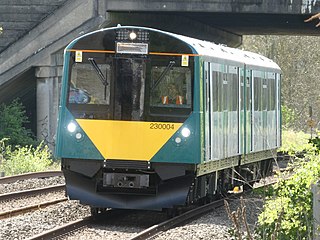
The Marston Vale line is the line between Bletchley and Bedford in England, a surviving remnant of the former Varsity Line between Oxford and Cambridge, most of which was closed in the late 1960s. The line is sponsored by the Marston Vale community rail partnership. The line is to be adopted and upgraded as part of East West Rail, a project underway to re-establish the Oxford–Cambridge route.
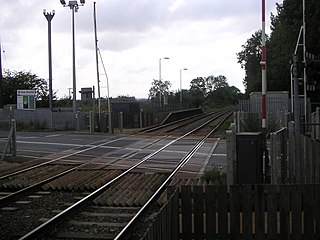
Bow Brickhill railway station is a railway station that serves the civil parishes of Bow Brickhill and Walton in the City of Milton Keynes, Buckinghamshire, England. It is on the Bletchley — Bedford Marston Vale Line, about 2 miles (3.25 km) east of Bletchley.
The Oxford–Cambridge Arc is a notional arc of agricultural and urban land at about 80 kilometres radius of London, in south central England. It runs between the British university cities of Oxford and Cambridge via Milton Keynes and other settlements in Bedfordshire, Buckinghamshire, Cambridgeshire, Northamptonshire, Oxfordshire at the northern rim of the London commuter belt. It is significant only in economic geography, with little physical geography in common.

Fenny Stratford is a railway station that serves the Fenny Stratford area of Milton Keynes, Buckinghamshire. It is on the Marston Vale Line that links Bletchley and Bedford, about one mile east of Bletchley railway station.

Bletchleyrailway station serves the southern parts of Milton Keynes, England, and the north-eastern parts of Aylesbury Vale. It is 47 miles (76 km) northwest of Euston, about 32 miles (51 km) east of Oxford and 17 miles (27 km) west of Bedford, and is one of the seven railway stations serving the Milton Keynes urban area.

Milton Keynes Central railway station serves Milton Keynes and surrounding parts of Bedfordshire, Buckinghamshire and Northamptonshire (England). The station is located on the West Coast Main Line about 50 miles (80 km) northwest of London. The station is served by Avanti West Coast intercity services, and by West Midlands Trains regional services.

Nuneaton railway station serves the market town of Nuneaton in Warwickshire, England. The station is managed by West Midlands Trains. It is served by three railway lines: the Trent Valley section of the West Coast Main Line (WCML), the Birmingham-Leicester-Peterborough line and the Coventry to Nuneaton branch line. The station was known, during the period 1924–1969, as Nuneaton Trent Valley, to distinguish it from the now closed Nuneaton Abbey Street station; many local people still refer to it as Trent Valley.

The Oxford–Bicester line is a railway line linking Oxford and Bicester in Oxfordshire, England. Opened in 1850, later becoming part of a through route to Cambridge, it closed in 1967 along with much of the rest of the original line. The section between Oxford and Bicester was reopened in 1987 as a branch line, and closed from early 2014 to late 2015 for a substantial upgrade in which it became part of a new route between Oxford and London Marylebone via High Wycombe. In addition, it is intended that by 2025 the original route eastwards will be restored as far as Bletchley allowing services to run to Bedford. This East West Rail project includes a long-term plan to re-establish the route through to Cambridge.
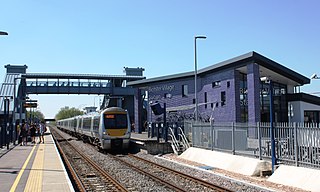
Bicester Village is one of two railway stations serving the town of Bicester in Oxfordshire. It is 12 miles (19 km) northeast of Oxford on the Oxford-Bedford line near its junction with the Chiltern Main Line. The renamed Bicester Village station reopened on 25 October 2015 with trains initially running between Oxford Parkway and London Marylebone. All trains serving it are operated by Chiltern Railways.

Bletchley TMD is a railway traction maintenance depot situated in Bletchley, Milton Keynes in Buckinghamshire, to the north east of Bletchley railway station, on a siding off the Marston Vale line. The depot is operated by London Northwestern Railway.

This history of Milton Keynes details its development from the earliest human settlements, through the plans for a 'new city' for 250,000 people in northern Southeast England, its subsequent urban design and development, to the present day. Milton Keynes, founded in 1967, is the largest settlement and only city in Buckinghamshire. At the 2021 census, the population of its urban area was estimated to have exceeded 256,000.

The Milton Keynes grid road system is a network of predominantly national speed limit, fully landscaped routes that form the top layer of the street hierarchy for both private and public transport in Milton Keynes, Buckinghamshire. The system is unique in the United Kingdom for its innovative use of street hierarchy principles: the grid roads run in between districts rather than through them. This arrangement permits higher speed limits due to the absence of buildings close to the roads – although more recently some have been limited in part to 40 mph (64 km/h). The grid road system also serves an important purpose of discouraging through-traffic from travelling through neighborhoods and thus reduces traffic noise and pollution in pedestrian areas. Motor traffic is segregated from pedestrian and leisure cycling traffic, which uses the alternative Milton Keynes redway system. Almost all grid junctions are roundabouts, and the absence of traffic lights enables free and efficient movement of traffic.
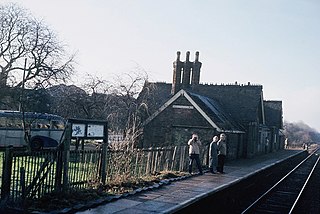
Winslow railway station refers to either one of two railway stations which historically served or is planned to serve, the town of Winslow in north Buckinghamshire, England. The original station (1850–1968) was on the former Varsity Line between Cambridge and Oxford. As of August 2023, construction of a new station nears completion and is scheduled to be served by East West Rail, as part of the plan to reinstate the Oxford–Cambridge service.
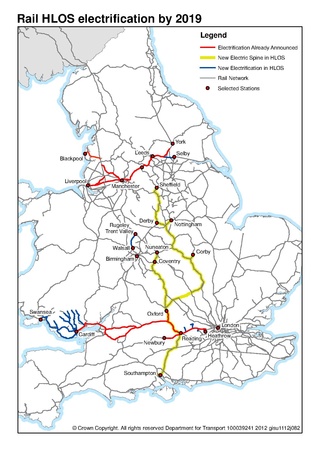
The "Electric Spine" was the name for part of a, now largely cancelled, rolling programme of railway electrification projects in England initially estimated to cost £800 million, but later thought to cost close to £3 billion. The aim was to form 25 kV AC overhead-wire electrified links northward from the Port of Southampton to major cities in northern and central England and dry port container terminals in the Midlands. The government wanted efficient electric-hauled freight trains to compete with road haulage.

East West Rail is a strategic aim to establish a new main line railway between East Anglia and South Wales. The immediate plan is to build a line linking Oxford and Cambridge via Bicester, Milton Keynes and Bedford, largely using the trackbed of the former Varsity Line. Thus it provides a route between any or all of the Great Western, Chiltern, West Coast, Midland, East Coast, West Anglia, Great Eastern and the Cotswold main lines, avoiding London. The new line will provide a route for potential new services between Southampton Central or Swansea and Ipswich or Norwich via Reading, Didcot and Ely, using existing onward lines. The government approved the western section in November 2011, with completion of this section expected by 2025.





















